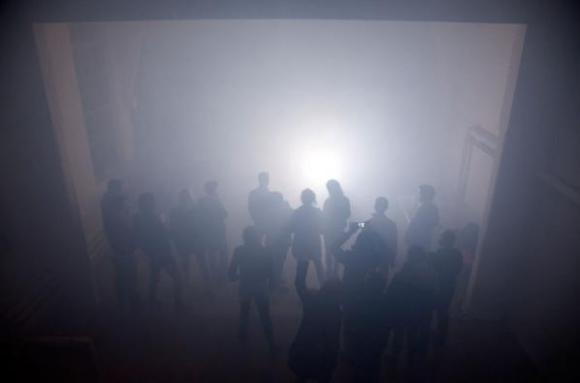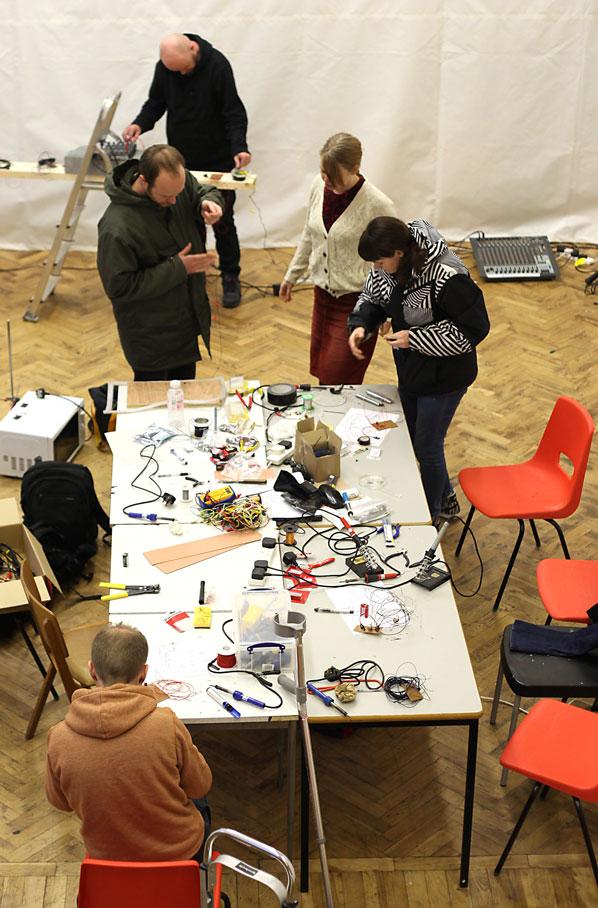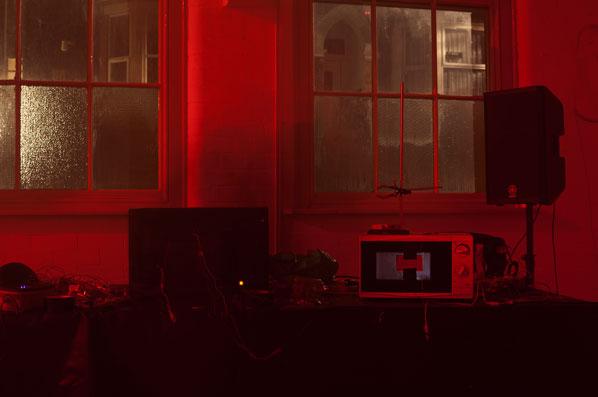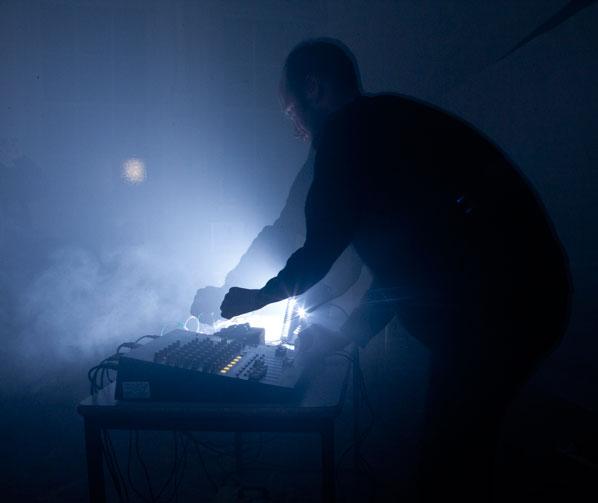



Featured image: Reactor Halls E09: Psychotronic Reactors Ryan Jordan & Jonathan Kemp // Photo: Julian Hughes
Intro: Nathan Jones has his head bent by an evening of psychogeophysics and laboratory manufactured noise at Reactor Halls E09: Psychotronic Reactors, by Ryan Jordan & Jonathan Kemp, at Reactor’s new space in Primary, Nottingham. Photos by Julian Hughes.
Approaching an abandoned school in Nottingham as dusk fell, I hopefully considered a new subgenre of science fiction. After the Social-Science Fiction recently reinvented in the film work of Ryan Trecartin, perhaps then the Lab-Science Fiction of the psychogeophysicists. An authored art of reality, one that intrudes under the pretense of the experimental environment and appropriates the materially integral as theoretically freakish.
A red throbbing smoke seethes out of two open windows at the side of the building, blue and yellow light jumps across the window ledge, electric whip-cracks heard down a corridor.
This is the ambience of Kemp and Jordan, UK practitioners of ‘psychogeophysics’. The location is Primary, the new art space in Nottingham, home to art experience specialists Reactor and thirty of the city’s other independent art initiatives – but in the weekend evenings, all-but-abandoned. The eerie emptiness of the building lends itself to the increasing feeling of having slipped into a fiction.
I enter the old school through a side door, some lost parent in a nightmare, through an empty hall, on the verge of an integral, unfathomable assessment.
The background reading on psychogeophysics[1] is rich with conceptual freakery, based on the application of experimental conditions to pick up signals and messages from the spiritual other – such as the notorious Electronic Voice Phenomena experiments of Konstantin Raudive, which reportedly discerned the voices of the dead in electronic noise. The term psychogeophysics itself is a half-tongue-in-cheek addition to the always-already-playful ‘psychogeography’ adding to concerns with the summative effects of environment and mind on arts practice, with a pataphysical enquiry into the earth’s wave-spectrum effects as they impact on consciousness.
Kebab coagulates with tension, rises up like a deep brown lava-lamp fluid.
Kemp and Jordan, today’s psychogeophysics representatives, work at the edges of the believable, taking inspiration and theoretical modes from outside – through the discredited or unfashionable sciences of the mind and matter which proliferated in the 18th century – and projecting them into an experimental arts environments in the form of dystopian noise/rave-scapes.

It’s a seductive atmosphere. But this isn’t a confidence trick, and the initial uncanniness is offset quite quickly by the manner of the artists themselves. Jonathan Kemp and Ryan Jordan have an approach which is the precise inverse of music-hall tricksters. Their diverse range of practices – taking in electronics and chemistry, installation, sound-performance, workshops – are unified around an obsessively open and unassuming approach, which is somehow difficult to reconcile with exotic conceptual grounding, and the promise of hallucinatory, out of body experience of the event. Throughout the evening, this integral conundrum between cynicism and being on the edge of discovery, plays out as a series of modesties, odd-ball crackpot demonstrations, chatty cigarette breaks, and noise abuse.

The basis for this evening’s bill was a laboratory workshop run by the artists, where participants – Nottingham based artists and Reator’s own esoteric cadre – could make their own devices with basic electronics – one for picking up electromagnetic waves, and another ‘solo-strobe’ unit which allows the user to stick two LED lights melted into lab glasses up close to their eye. It is these glasses that provide the first ‘performance’ moment of the night. We are invited to put the glasses on, and they are wired into the sound system, so each time the light goes on or off it makes a popping noise. Keeping our eyes closed, we can alter the frequency at which the lights flash on our eyes, and the resulting pulses or screams.
Blood strains in eye-lids. Crystaline salt remnants on pupil. Granular arrangement of optical receptors just before the brain. A familiar green and purple mesh which sieves the world into your soft-matter. Turning, the green grains mould together into white-hot orbs.
A pattern emerges where Kemp and Jordan take it in turns to set up and overload to breaking point a kind of ephemeral circuit between electronic equipment, geological objects, and our own nervous systems. Are we humans, or resistors?
The optical nerves, neuronal receptors and bodies of the audience are, to varying degrees of success, co-opted into a system of electro-magnetic flow across wires and solid matter – one which theoretical precursors might attribute to any number of things, from spirit-world contact, to the healing properties of rock, but that the artists themselves seem content to simply evolve and then break.

Jonathan Kemp puts tinfoil in a microwave that has a solar panel taped to it. He strings together a number of circuits made by workshop participants, and wires them to a large rock. There is the feeling of being part of something truly special and interesting, twinned with the feeling that an entirely intelligent and sane person might consider the whole evening to be some kind of elaborate joke on an unwitting reviewer. It isn’t a complementary train of thought to follow, and one which inevitably leads you to wonder whether the evening could be better presented. Why no introductions, no accompanying materials, no ‘show’? For a moment, I imagine my mum and dad standing in the centre of the small school hall demanding to know what is going on.
Back inside after a cigarette in the cracked and melted night, we are finally barraged with a single strobe light, by Ryan Jordan. There is a set of crystals set in front of the strobe also, so the electromagnetic pulses given off by them as innate response to the light stimulation, make the speakers pop and crack. The timing of light and sound is immaculate, and richly textured. Our own circuitry fully descended now from the cerebral, critical, suspicious human being, to a purely biological system, granulating, flipping on and off with the light and sound. Somewhere deep inside the purple matter a tiny voice wondering when it will end.

Rising, the mesh pulled upwards by the orbs distorting the front of the eyeball, pushing up at the iris like a small hot hand. The brain responds with a rumbling tide on its underside. The glitching and popping at the ears make your mouth turn up into a grimace.
Among the noise, the roughness and the seeming ambivalence of the artists towards the audience, a feeling of our own innate connection to the technological and chemical comes across very strongly. This connectivity is the hard-won evocation of two artists who have invested fully in the material consequences of their media, a feeling which has lasted well beyond the evening, for me. I did wonder though, whether this one successful evocation is dependent on the anti-showmanship of the artists, or in fact limited by the attention paid to the audience experience – a contrast which is especially stark given the context of the Reactor collective’s own portfolio of experiential arts environments. Perhaps not a new genre of sci-fi then, but a discipline that insists along with the noise practices of the last few decades, on the outer limits of entertainment.